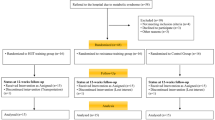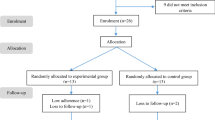Abstract
Aims and background
Physical inactivity is leading to obesity and consequently insulin resistance and diabetes. Feasible and cost efficient strategies like Pilates and total body resistance exercise (TRX) training can impede obesity and its compilation. The aim of this study was to investigate the effects of 8 weeks Pilates and TRX training programs on irisin concentration and insulin resistance in overweight women.
Method
Thirty overweight women (Body mass index (BMI): 25–29.9 kg/m2) were divided, based on their BMI, into 3 groups; control, Pilates and TRX. The participants in the training groups were subjected to moderate intensity of Pilates or TRX exercise training 3 times a week for 8 weeks. Blood samples were taken at pre-test and 48 h after the last training session and used for analyzing irisin, insulin and glucose. Data were analyzed by ANCOVA and paired-samples t-test.
Results
The finding showed that the Pilates training decreased body weight and BMI compared to the pre-test (P < 0.05). Also, it has been revealed that irisin concentration in response to Pilates and TRX training programs were increased in comparison with the control group (P < 0.05). However, there was no significant difference in irisin concentrations between training groups (p > 0.05). Moreover, fasting insulin, glucose and insulin resistance were significantly reduced after exercise intervention compared to the pre-test which were significantly lowered compared to the control group as well.
Conclusion
The results suggest Pilates and TRX trainings are two efficient model of exercise that by eliciting an exercise-hormone, irisin, can improve insulin resistance in overweight women.

Similar content being viewed by others
Data availability statement
The data that support the findings of this study are available from the corresponding author upon reasonable request.
References
Morgen CS, Sørensen TI. Global trends in the prevalence of overweight and obesity. Nat Rev Endocrinol. 2014;10(9):513–4.
Organization WH. Noncommunicable diseases country profiles 2018. 2018.
Sousa RALD, Improta-Caria AC, Souza BSdF. Exercise–linked irisin: consequences on mental and cardiovascular health in type 2 diabetes. Int J Mol Sci. 2021;22(4):2199.
Zhang T, Zhang H, Li Y, Li S, Fernandez C, Bazzano L, et al. Long-term impact of temporal sequence from childhood obesity to hyperinsulinemia on adult metabolic syndrome and diabetes: the Bogalusa heart study. Sci Rep. 2017;7(1):1–7.
Gizaw M, Anandakumar P, Debela T. A review on the role of irisin in insulin resistance and type 2 diabetes mellitus. J Pharmacopuncture. 2017;20(4):235.
Zhang Y, Li R, Meng Y, Li S, Donelan W, Zhao Y, et al. Irisin stimulates browning of white adipocytes through mitogen-activated protein kinase p38 MAP kinase and ERK MAP kinase signaling. Diabetes. 2014;63(2):514–25.
Hee Park K, Zaichenko L, Brinkoetter M, Thakkar B, Sahin-Efe A, Joung KE, et al. Circulating irisin in relation to insulin resistance and the metabolic syndrome. J Clin Endocrinol Metab. 2013;98(12):4899–907.
Pardo M, Crujeiras AB, Amil M, Aguera Z, Jimenez-Murcia S, Banos R, et al. Association of irisin with fat mass, resting energy expenditure, and daily activity in conditions of extreme body mass index. Int J Endocrinol. 2014;2014.
Riddell MC, Miadovnik L, Simms M, Li B, Zisser H. Advances in exercise, physical activity, and diabetes mellitus. Diabetes Technol Ther. 2013;15(S1):S-96-S-106.
Benedini S, Dozio E, Invernizzi PL, Vianello E, Banfi G, Terruzzi I, et al. Irisin: a potential link between physical exercise and metabolism—an observational study in differently trained subjects, from elite athletes to sedentary people. J Diabetes Res. 2017;2017.
Choi KM. The impact of organokines on insulin resistance, inflammation, and atherosclerosis. Endocrinol Metab. 2016;31(1):1.
Polyzos SA, Kountouras J, Shields K, Mantzoros CS. Irisin: a renaissance in metabolism? Metab-Clin Exp. 2013;62(8):1037–44.
Kim H-J, Lee H-J, So B, Son JS, Yoon D, Song W. Effect of aerobic training and resistance training on circulating irisin level and their association with change of body composition in overweight/obese adults: a pilot study. Physiol Res. 2016;65(2):271.
Boström P, Wu J, Jedrychowski MP, Korde A, Ye L, Lo JC, et al. A PGC1-α-dependent myokine that drives brown-fat-like development of white fat and thermogenesis. Nature. 2012;481(7382):463–8.
Tsuchiya Y, Ando D, Takamatsu K, Goto K. Resistance exercise induces a greater irisin response than endurance exercise. Metabolism. 2015;64(9):1042–50.
Hun-Young P, Won-Sang J, Jisu K, Hyejung Hwang KL. Changes in the paradigm of traditional exercise in obesity therapy and application of a new exercise modality: A narrative review article. Iran J Public Health. 2019;48(8):1395.
Gaedtke A, Morat T. TRX suspension training: A new functional training approach for older adults–development, training control and feasibility. Int J Exerc Sci. 2015;8(3):224.
Rayes ABR, de Lira CAB, Viana RB, Benedito-Silva AA, Vancini RL, Mascarin N, et al. The effects of Pilates vs. aerobic training on cardiorespiratory fitness, isokinetic muscular strength, body composition, and functional tasks outcomes for individuals who are overweight/obese: a clinical trial. PeerJ. 2019;7:e6022.
Janot J, Heltne T, Welles C, Riedl J, Anderson H, Howard A, et al. Effects of TRX versus traditional resistance training programs on measures of muscular performance in adults. J Fitness Res. 2013;2(2):23–38.
de Souza Cavina AP, Junior EP, Machado AF, Biral TM, Lemos LK, Rodrigues CRD, et al. Effects of the Mat Pilates Method on Body Composition: Systematic Review With Meta-Analysis. J Phys Act Health. 2020;17(6):673–81.
Wang Y, Chen Z, Wu Z, Ye X, Xu X. Pilates for overweight or obesity: A meta-analysis. Front Physiol. 2021;12.
Fernández-Rodríguez R, Álvarez-Bueno C, Ferri-Morales A, Torres-Costoso AI, Cavero-Redondo I, Martínez-Vizcaíno V. Pilates method improves cardiorespiratory fitness: a systematic review and meta-analysis. J Clin Med. 2019;8(11):1761.
Melo KCB, de Souza AF, Júnior CCMC, de Andrade KTP, Moreira SR. Pilates method training: Functional and blood glucose responses of older women with type 2 diabetes. J Strength Condition Res. 2020;34(4):1001–7.
Yucel H, Uysal O. Pilates-based mat exercises and parameters of quality of life in women with Type 2 diabetes. Iran Red Crescent Med J. 2018;20(S1).
Nowak A, Morawiec M, Gabrys T, Nowak Z, Szmatlan-Gabryś U, Salcman V. Effectiveness of Resistance Training with the Use of a Suspension System in Patients after Myocardial Infarction. Int J Environ Res Public Health. 2020;17(15):5419.
Ellefsen S, Vikmoen O, Slettaløkken G, Whist JE, Nygård H, Hollan I, et al. Irisin and FNDC5: effects of 12-week strength training, and relations to muscle phenotype and body mass composition in untrained women. Eur J Appl Physiol. 2014;114(9):1875–88.
Yang D, Yang Y, Li Y, Han R. Physical exercise as therapy for type 2 diabetes mellitus: from mechanism to orientation. Ann Nutr Metab. 2019;74(4):313–21.
Du X-L, Jiang W-X. Lower circulating irisin level in patients with diabetes mellitus: a systematic review and meta-analysis. Horm Metab Res. 2016;48(10):644–52.
Arhire LI, Mihalache L, Covasa M. Irisin: a hope in understanding and managing obesity and metabolic syndrome. Front Endocrinol. 2019;10:524.
Guilford BL, Parson JC, Grote CW, Vick SN, Ryals JM, Wright DE. Increased FNDC 5 is associated with insulin resistance in high fat-fed mice. Physiol Rep. 2017;5(13):e13319.
Dianatinasab A, Koroni R, Bahramian M, Bagheri-Hosseinabadi Z, Vaismoradi M, Fararouei M, et al. The effects of aerobic, resistance, and combined exercises on the plasma irisin levels, HOMA-IR, and lipid profiles in women with metabolic syndrome: A randomized controlled trial. J Exerc Sci Fit. 2020;18(3):168–76.
Colberg SR, Sigal RJ, Fernhall B, Regensteiner JG, Blissmer BJ, Rubin RR, et al. Exercise and type 2 diabetes: the American College of Sports Medicine and the American Diabetes Association: joint position statement. Diabetes Care. 2010;33(12):e147–67.
Norheim F, Langleite TM, Hjorth M, Holen T, Kielland A, Stadheim HK, et al. The effects of acute and chronic exercise on PGC-1α, irisin and browning of subcutaneous adipose tissue in humans. FEBS J. 2014;281(3):739–49.
Gouni-Berthold I, Berthold HK, Huh JY, Berman R, Spenrath N, Krone W, et al. Effects of lipid-lowering drugs on irisin in human subjects in vivo and in human skeletal muscle cells ex vivo. PLoS ONE. 2013;8(9):e72858.
Momenzadeh S, Zamani S, Pourteymourfard-Tabrizi Z, Barreiro C, Jami M-S. Muscles proteome analysis; irisin administration mimics some molecular effects of exercise in quadriceps muscle. Biochimie. 2021;189:144–57.
Liu T-Y, Shi C-X, Gao R, Sun H-J, Xiong X-Q, Ding L, et al. Irisin inhibits hepatic gluconeogenesis and increases glycogen synthesis via the PI3K/Akt pathway in type 2 diabetic mice and hepatocytes. Clin Sci. 2015;129(10):839–50.
Qiao X, Nie Y, Ma Y, Chen Y, Cheng R, Yin W, et al. Irisin promotes osteoblast proliferation and differentiation via activating the MAP kinase signaling pathways. Sci Rep. 2016;6(1):1–12.
Viitasalo A, Atalay M, Pihlajamäki J, Jääskeläinen J, Korkmaz A, Kaminska D, et al. The 148 M allele of the PNPLA3 is associated with plasma irisin levels in a population sample of Caucasian children: the PANIC Study. Metabolism. 2015;64(7):793–6.
Steinberg GR, Michell BJ, van Denderen BJ, Watt MJ, Carey AL, Fam BC, et al. Tumor necrosis factor α-induced skeletal muscle insulin resistance involves suppression of AMP-kinase signaling. Cell Metab. 2006;4(6):465–74.
Xiong X-Q, Chen D, Sun H-J, Ding J, Wang J-J, Chen Q, et al. FNDC5 overexpression and irisin ameliorate glucose/lipid metabolic derangements and enhance lipolysis in obesity. Biochim Biophys Acta (BBA)-Mol Basis Dis. 2015;1852(9):1867–75.
Xiong X-Q, Geng Z, Zhou B, Zhang F, Han Y, Zhou Y-B, et al. FNDC5 attenuates adipose tissue inflammation and insulin resistance via AMPK-mediated macrophage polarization in obesity. Metabolism. 2018;83:31–41.
Timmons JA, Baar K, Davidsen PK, Atherton PJ. Is irisin a human exercise gene? Nature. 2012;488(7413):E9–10.
Atherton PJ, Babraj JA, Smith K, Singh J, Rennie MJ, Wackerhage H. Selective activation of AMPK-PGC-1α or PKB-TSC2-mTOR signaling can explain specific adaptive responses to endurance or resistance training-like electrical muscle stimulation. FASEB J. 2005;19(7):1–23.
Acknowledgements
The authors would like to thank all the participants who gave us their time and participated in this trial.
Funding
The author(s) received no specific funding for this work.
Author information
Authors and Affiliations
Corresponding author
Ethics declarations
Disclosure of interest
The authors declare that they have no conflicts of interest concerning this article.
Additional information
Publisher's Note
Springer Nature remains neutral with regard to jurisdictional claims in published maps and institutional affiliations.
Rights and permissions
About this article
Cite this article
Rahimi, M., Nazarali, P. & Alizadeh, R. Pilates and TRX training methods can improve insulin resistance in overweight women by increasing an exercise-hormone, Irisin. J Diabetes Metab Disord 20, 1455–1460 (2021). https://doi.org/10.1007/s40200-021-00887-z
Received:
Accepted:
Published:
Issue Date:
DOI: https://doi.org/10.1007/s40200-021-00887-z




